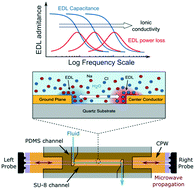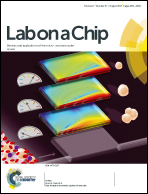Modeling electrical double-layer effects for microfluidic impedance spectroscopy from 100 kHz to 110 GHz†‡
Abstract
Broadband microfluidic-based impedance spectroscopy can be used to characterize complex fluids, with applications in medical diagnostics and in chemical and pharmacological manufacturing. Many relevant fluids are ionic; during impedance measurements ions migrate to the electrodes, forming an electrical double-layer. Effects from the electrical double-layer dominate over, and reduce sensitivity to, the intrinsic impedance of the fluid below a characteristic frequency. Here we use calibrated measurements of saline solution in microfluidic coplanar waveguide devices at frequencies between 100 kHz and 110 GHz to directly measure the double-layer admittance for solutions of varying ionic conductivity. We successfully model the double-layer admittance using a combination of a Cole–Cole response with a constant phase element contribution. Our analysis yields a double-layer relaxation time that decreases linearly with solution conductivity, and allows for double-layer effects to be separated from the intrinsic fluid response and quantified for a wide range of conducting fluids.



 Please wait while we load your content...
Please wait while we load your content...